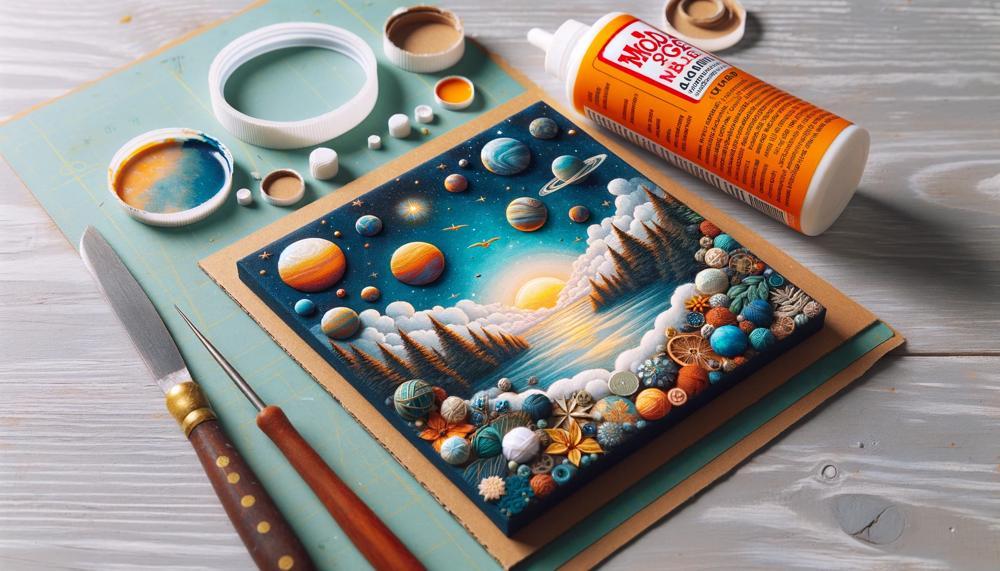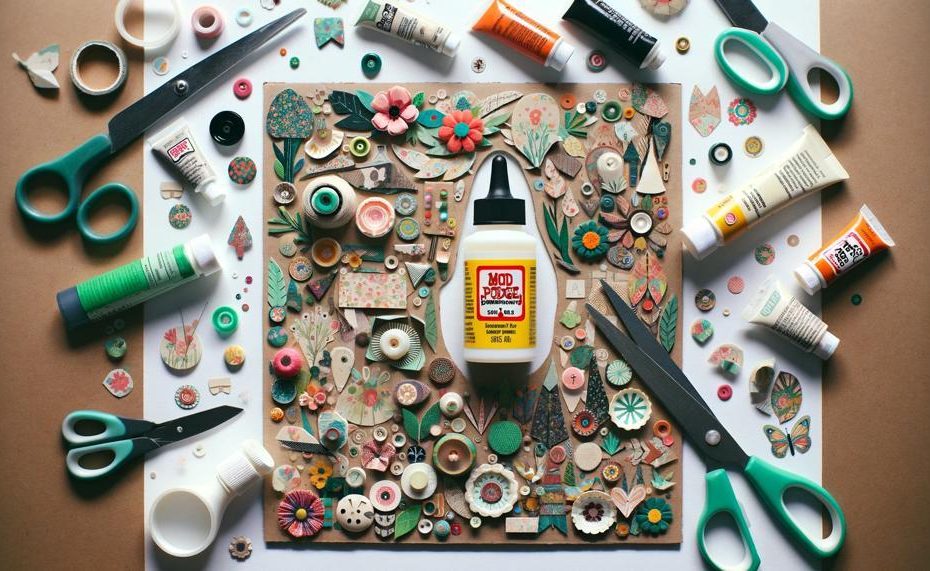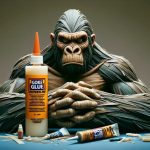Are you looking to add a touch of creativity to your crafting projects? Combining the flexibility of fabric with the sturdiness of cardboard opens up a world of possibilities for hobbyists and professional crafters alike. Enter Mod Podge, the versatile adhesive that has become a staple in the world of craft for its reliability and ease of use.
Whether you’re creating custom home décor, personalized gifts, or simply experimenting with mixed media art, understanding how to properly use Mod Podge to bond fabric to cardboard is a game-changer.
So, can i use mod podge to glue fabric to cardboard?
Yes, Mod Podge can be used to glue fabric to cardboard. It can be used to glue and seal paper or fabric to surfaces like cardboard, canvas, or wood. It can also be used as a sealer to protect acrylic paints and decoupage artwork.
Get ready to arm yourself with the know-how to create durable, beautiful fabric-cardboard creations with the magic of Mod Podge. Let’s dive in and get our hands a little sticky—in the best way possible.
Table of Contents
- 1 Benefits of Using Mod Podge for Gluing Fabric to Cardboard
- 2 Preparing the Surface Before Applying Mod Podge
- 3 How to Apply Mod Podge to Glue Fabric to Cardboard
- 4 Tips for Working with Mod Podge
- 5 Is Mod Podge Suitable for Heavy-Duty Applications?
- 6 Different Finishes Available with Mod Podge
- 7 Testing a Small Piece Before Starting Your Project
- 8 Common Mistakes When Working with Mod Podge
- 9 Conclusion
Benefits of Using Mod Podge for Gluing Fabric to Cardboard
Adherence and Durability
Mod Podge creates a tenacious bond between fabric and cardboard, ensuring the fabric stays affixed even with handling.
The adhesive forms a seal around the fabric’s edges, guarding against fraying and wear, a boon for projects needing longevity.
Ease of Use
The application of Mod Podge is straightforward; a brush or sponge applicator suffices, and it dries swiftly, which spares the crafter a lengthy wait.
Its water-soluble nature makes for a hassle-free cleanup with just soap and water.
Aesthetic Finish
After drying, Mod Podge leaves a transparent coat that showcases the fabric’s colours and patterns without distortion.
The choice of finishes—matte, glossy, or satin—allows for creative expression in the final look of the craft.
Protection
Acting as a sealant, Mod Podge shields the fabric and cardboard from moisture, dirt, and other external elements that could damage the craft.
Comparison to Other Glues
| Feature | Mod Podge | Other Glues |
| Drying Time | Quick | Varies |
| Cleanup | Easy (soap and water) | May require solvents |
| Finish | Transparent, choice of finishes | Often leaves residue or changes texture |
| Sealant Abilities | Doubles as a protective sealant | Not all glues offer this |
| Versatility | Excellent for light-duty tasks | Some are designed for more heavy-duty applications |
While Mod Podge provides a strong, aesthetically pleasing bond with protective qualities, it may not be the cavalry for more demanding tasks due to its water-based composition. In such cases, extra layers or topcoats might be needed for reinforcement.
Comparatively, other adhesives might offer more strength but lack the ease of use and the array of finishes that Mod Podge brings to the table.
Preparing the Surface Before Applying Mod Podge
To ensure a strong adhesion and a smooth finish when applying Mod Podge to bond fabric to cardboard, follow these essential steps:
| Step | Action | Tip |
| Cleaning | Wipe cardboard with a dry cloth | Avoid damp cloths to prevent warping |
| Fabric Test | Apply Mod Podge to a scrap piece | Check for color bleed or texture changes |
| Optional Basecoat | Apply acrylic paint if desired | Choose a color that complements your fabric |
| Cut and Measure | Trim fabric to fit the cardboard | Use sharp scissors for clean cuts |
| Apply Mod Podge | Spread an even layer on cardboard | Don’t drench it; keep it even |
| Place Fabric | Smooth fabric over Mod Podge | Work from the center outwards |
| Drying | Wait 15-20 minutes | Patience leads to stellar results |
| Sanding | Lightly sand between coats | Use a fine grit for a polished look |
| Sealing | Apply a clear sealer if needed | Protects your masterpiece |
| Extra Resources | Check out online project galleries | Perfect for inspiration |
How to Apply Mod Podge to Glue Fabric to Cardboard
To fix fabric to cardboard with Mod Podge, follow these steps for a fine finish:
Surface Prep
Ensure the fabric is smooth by ironing out creases and the cardboard is free from grime.
Initial Mod Podge Layer
| Tool | Action | Outcome |
| Foam Brush or Paintbrush | Spread a thin Mod Podge layer on cardboard | Preps the surface for fabric adherence |
Fabric Placement
Carefully position the fabric on the glue, smoothing out to sidestep any wrinkles or air pockets.
Top Mod Podge Layer
| Tool | Action | Outcome |
| Same Brush | Cover the fabric with another Mod Podge layer | Encases fabric for protection |
Drying Time
Patience is key. Let the Mod Podge dry fully, which might take around a full day.
Seal the Edges
Run a thin Mod Podge strip along fabric edges to fortify and guard against frays.
Additional Layers (Optional)
For greater durability, slap on more Mod Podge layers, letting each one dry thoroughly.
Practice Makes Perfect
Conduct a trial with scraps to gauge bond strength and the best finish for your project.
Sidestep Blunders
Apply Mod Podge moderately, allot ample drying time, and select an apt formula for your task.
Tips for Working with Mod Podge
To master the craft of adhering fabric to cardboard with Mod Podge, follow these pointers:
Selecting the Correct Formula
Choose a Mod Podge formula that aligns with your project’s requirement, whether it demands waterproof features or a specific finish like matte.
| Step | Action | Consideration |
| Formula Selection | Choose the right Mod Podge variant | Finish and durability needed |
| Prep Surfaces | Clean and dry fabric and cardboard | Ensures strong adhesion |
| Glue Application | Apply thin, even layer | Prevents stiffness |
| Design and Texture | Add layers and embellishments | Creativity and personal touch |
| Delicate Fabrics | Use dabbing for application | Preserves fabric integrity |
| Material Variety | Experiment with different fabrics | Adds depth and character |
| Stitching Fabric | Use quilting techniques | Professional finish |
| Test on Stretchy Fabric | Perform a patch test | Checks for stiffness |
| Beyond Cardboard | Adhere to wood, glass, etc. | Expands creative possibilities |
Is Mod Podge Suitable for Heavy-Duty Applications?
Mod Podge is a stalwart in the crafting world, known for its tenacious hold in light to medium-duty projects. When it comes to heavy-duty applications, one must be a bit more discerning. This adhesive sealer shines in its versatility and the finesse it brings to projects but might falter under the heavy strain. It’s a champ for decoupage, a protector of photographs, and a binder of lightweight fabric to cardboard.
For a robust application, like outdoor furnishings or high-traffic items, Mod Podge may not be the Hercules you need. Its fortitude is ample for daily use items that aren’t subject to the rigours of Mother Nature or the constant handling of the bustling masses.
Bonding Strength of Mod Podge for Fabric to Cardboard:
| Criteria | Mod Podge Performance | Note |
| Adhesion | Strong | Best with proper surface prep |
| Durability | High | Sealant properties enhance protection |
| Flexibility | Moderate | Allows some movement without cracking |
| Water-Resistance | Varies | Outdoor formula available for increased resistance |
| Finish | Matte/Glossy | Options available for personal preference |
In conclusion, while Mod Podge can secure fabric to cardboard with aplomb for interior use and less demanding situations, it’s not cut out for heavy-duty outdoor use or items enduring heavy wear and tear.
Different Finishes Available with Mod Podge
Mod Podge, the crafter’s staple, is not just a single product but a collection tailored for various finishes and applications.
Here’s a breakdown of the different finishes you can employ to stick fabric onto cardboard and the influence they may have on your project.
Mod Podge Finishes:
| Finish Type | Description | Effect on Fabric to Cardboard Adhesion |
| Gloss | Lends a shiny, glossy surface | Strong adhesion, can make fabric appear more vibrant |
| Matte | Provides a flat, non-reflective finish | Strong adhesion, maintaining the fabric’s natural look |
| Outdoor | Enhanced durability for exterior use | Extra strong adhesion, protects against elements |
| Fabric | Formula designed for textiles | Strong adhesion, washable, and fabric remains flexible |
| Antique Matte | Flat finish with a vintage brown tint | Strong adhesion, gives fabric an aged appearance |
| Extreme Glitter | Highly sparkly finish | Strong adhesion, best for decorative effects |
| Super Gloss | Ultra shiny, clear finish | Used as a top coat, not recommended for adhesion |
| Brushstroke | Textured, hand-painted look | Good adhesion, adds dimensional quality to fabric |
Adhesion Tips:
To ensure your fabric adheres to cardboard seamlessly, consider these pointers.
Firstly, apply Mod Podge evenly with a soft-bristled brush. For a refined finish, sand between coats lightly. Bear in mind, the Outdoor and Fabric formulas provide a durable bond, especially suited for items that might endure more handling.
The Antique Matte and Extreme Glitter are more specific to the aesthetic you’re aiming to achieve, both ensuring a strong bond.

Crafting Wisdom:
Cathie and Steve’s video guide gives a practical demonstration of these finishes. It’s a nifty resource for seeing them in action. Remember, the finish you pick will dictate the ambiance of your craft. Whether you’re after the gleam of Gloss or the subtlety of Matte, Mod Podge has got your back, holding fabric to cardboard with steadfastness.
Ultimately, the formula you choose should align with your project’s needs and the visual flair you’re after.
Testing a Small Piece Before Starting Your Project
Testing a small piece of fabric and cardboard with Mod Podge before embarking on a larger project is a savvy move. It gives you a snapshot of how the materials will react to one another and to the adhesive. Let’s break it down:
| Aspect | Test Purpose | Benefit |
| Adhesion | Check the bond strength | Confidence in durability |
| Color and Texture | Identify any changes | Avoids ruining the aesthetic |
| Dry Time | Understand setting duration | Effective project timing |
By conducting this crafty reconnaissance, you’re not just guessing; you’re ensuring that your masterpiece will hold up and look splendid.
Common Mistakes When Working with Mod Podge
When working with Mod Podge to adhere fabric to cardboard, steering clear of a few pitfalls can make the difference between a craft success and a sticky disaster.
| Common Mistake | Consequences | Prevention Tips |
| Excessive Mod Podge | Wrinkles and bubbles in fabric | Use just enough to coat the surface |
| Insufficient Drying Time | Sticky and unset adhesive | Wait 15-20 minutes between layers |
| Inappropriate Mod Podge Variant | Poor finish or inadequate protection | Choose the right type for your project |
| Poor Surface Preparation | Imperfections in adhesion | Clean and dry the cardboard thoroughly |
| Application Technique | Uneven coating and imperfections | Apply evenly, smoothing as you go |
| Lack of Sealing | Vulnerability to damage | Seal with a topcoat or sealer |
Conclusion
In summary, Mod Podge is an excellent medium that crafters may use to glue fabric to cardboard, giving them a dependable and adaptable choice for their creations. In addition to providing an attractive finish, good adhesion, and convenience of application, it also serves as a weatherproof sealer. It may not be the strongest adhesive for demanding jobs, but it works well for light-duty applications and is available in a range of finishes to accommodate any creative concept.
From choosing the appropriate materials and prepping surfaces to applying the product and resolving typical problems, the book has thoroughly covered everything. Additionally, it has offered helpful advice on how to get the best results, such giving enough time for drying, applying equal layers, and strengthening edges for added durability.
Knowing how to use Mod Podge to attach fabric to cardboard may take your creative projects to the next level of creativity and professionalism, regardless of experience level. With the comprehensive instructions and advice offered, you’ll be well-equipped to make exquisite, durable fabric-cardboard crafts.






